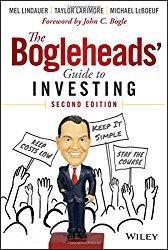At the beginning of this series, we presented the basic, master portfolio, which, like a master dough recipe or a master sauce, can be adjusted to meet your particular investing needs. Hopefully, you’ll take the time to go back and read that post, along with the one that comes after it which explains how the Master Portfolio works and why it is composed in the way that it is. Today we’ll show how you take the Master Portfolio and adjust it for the needs of a millennial investor who is investing for retirement many years in the future, or really anyone who is investing where there are many years before the money is needed, or no particular need for the money (you’re just investing to grow wealth and don’t need the money at any particular time). Here, take “many years” to mean at least ten to twenty years.
(This is part of a series of articles to teach those who are new to investing how to invest. To find other articles in this series, choose “Beginner Investing Class” under “Investing” in the menu at the top of the page. If you have questions or you’d like a topic to be covered, please leave a comment at the bottom of the post.)

Waht is the Master Portfolio?
The Master Portfolio is made up of a set of index mutual funds. Mutual funds are where a group of investors pool their money together and then have a manager buy a portfolio – a group – of stocks (or other assets like bonds) for them. An index fund is a mutual fund where the manager is just given a list of stocks to buy and he buys those stocks. Because the manager buys the stocks on the list with an index fund, rather than doing a lot of research to figure out what to buy as he does with a managed mutual fund, your costs as an investor are low. It has been shown that low costs are one of the main factors to maximize returns. As the investor, you choose which particular list of stocks you wish to buy from a variety of lists out there. You then let the manager take care of the grunt work of buying the stocks.
It may sound difficult to decide which list of stocks to buy. It is true that choosing a good list can be quite daunting, especially since there are dozens of them out there. But that is why you’re reading The Small Investor. We’ve done that for you by creating the Master Portfolio. For the Master Portfolio, we choose five different lists of stocks in which to invest. Once again, the master portfolio is composed of the following index funds:
20% General Large-Cap US Stock Index Fund
20% General Small-Cap US Stock Index Fund
20% International Stock Index Fund
20% General US Bond Index Fund
20% US Real-Estate Investment Trust (REIT) Fund

Want all the details on using Investing to grow financially Independent? Try The SmallIvy Book of Investing.
So why modify the Master Portfolio?
The master portfolio would be perfectly suitable for a millennial investor, but we can do better. The reason is that a young investor who doesn’t need the money for living expenses in less than ten to twenty years (or more) can afford to take a few more risks and shift towards more stocks and fewer bonds.
Wait! No, that isn’t true. You aren’t taking more risks!
Many people will tell you that stocks are risky and bonds are safe. It is true that if you are holding investments for a short period of time, like a few years, you have a greater chance of seeing a big drop in your portfolio value if you have all stocks, or mainly stocks, than if you have a balanced portfolio of stocks and bonds. (All bonds isn’t the safest thing either. Actually, a portfolio of 60% bonds and 40% stocks is safest since stocks sometimes go up when bonds go down.) It is not that uncommon to see a broad-based stock portfolio drop by 30-40% over a period of a week or two. It happens about once per decade.
But if you also factor in time, the risk of holding all stocks and the risk of holding a balanced portfolio become about the same. The chance that you’ll actually lose money holding a stock index fund like one of those listed in the Master Portfolio if you hold onto that fund for at least ten years is almost zero. It is about the same chance that the world economy will collapse, and that would take something like a nuclear war, mass riots, or an asteroid hit. (You may think that one of those scenarios is actually pretty likely to happen over the next fifty years, but even if it did, your bonds would be worthless too.)
Now if you look at the returns from an all-stock portfolio versus a balanced portfolio, you’ll see that you’ll get 5% per year more from all-stocks than you’ll get from the balanced portfolio. So basically, by adding bonds to your stock portfolio, you’ll be giving up 5% per year while not really reducing your risk. You may feel better since when years like 2008 occur and the stock market drops by 40%, you’ll only be down 20% with a balanced portfolio, but as you saw from that little debacle, your stock portfolio will recover and then some if you just keep holding on.
How to adjust the Master Portfolio:
So, the basic change that we’ll make to the Master Portfolio is that we’ll cut or eliminate the bonds. (If your stomach still gets queasy in a market drop even though you now know that things will be fine if you just hold on, go ahead and keep 10% of your money in bonds.) We’ll also shift more of the money to small stocks since small stocks outperform large stocks over long periods of time. Finally, we’ll cut our REIT (real estate) portfolio portion since stocks will also outperform REITs over long periods. So, here is the new portfolio:
30% General Large-Cap US Stock Index Fund
40% General Small-Cap US Stock Index Fund
20% International Stock Index Fund
10% US Real-Estate Investment Trust (REIT) Fund
Have a burning investing question you’d like answered? Please send to [email protected] or leave in a comment.
Follow on Twitter to get news about new articles. @SmallIvy_SI
Disclaimer: This blog is not meant to give financial planning or tax advice. It gives general information on investment strategy, picking stocks, and generally managing money to build wealth. It is not a solicitation to buy or sell stocks or any security. Financial planning advice should be sought from a certified financial planner, which the author is not. Tax advice should be sought from a CPA. All investments involve risk and the reader as urged to consider risks carefully and seek the advice of experts if needed before investing.
